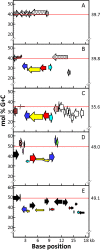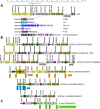Two putative glutamate decarboxylases of Streptococcus pneumoniae as possible antigens for the production of anti-GAD65 antibodies leading to type 1 diabetes mellitus
- PMID: 37154976
- PMCID: PMC10165594
- DOI: 10.1007/s10123-023-00364-y
Two putative glutamate decarboxylases of Streptococcus pneumoniae as possible antigens for the production of anti-GAD65 antibodies leading to type 1 diabetes mellitus
Abstract
Type 1 diabetes mellitus (T1DM) has been increasing in prevalence in the last decades and has become a global burden. Autoantibodies against human glutamate decarboxylase (GAD65) are among the first to be detected at the onset of T1DM. Diverse viruses have been proposed to be involved in the triggering of T1DM because of molecular mimicry, i.e., similarity between parts of some viral proteins and one or more epitopes of GAD65. However, the possibility that bacterial proteins might also be responsible for GAD65 mimicry has been seldom investigated. To date, many genomes of Streptococcus pneumoniae (the pneumococcus), a prominent human pathogen particularly prevalent among children and the elderly, have been sequenced. A dataset of more than 9000 pneumococcal genomes was mined and two different (albeit related) genes (gadA and gadB), presumably encoding two glutamate decarboxylases similar to GAD65, were found. The various gadASpn alleles were present only in serotype 3 pneumococci belonging to the global lineage GPSC83, although some homologs have also been discovered in two subspecies of Streptococcus constellatus (pharyngis and viborgensis), an isolate of the group B streptococci, and several strains of Lactobacillus delbrueckii. Besides, gadBSpn alleles are present in > 10% of the isolates in our dataset and represent 16 GPSCs with 123 sequence types and 20 different serotypes. Sequence analyses indicated that gadA- and gadB-like genes have been mobilized among different bacteria either by prophage(s) or by integrative and conjugative element(s), respectively. Substantial similarities appear to exist between the putative pneumococcal glutamate decarboxylases and well-known epitopes of GAD65. In this sense, the use of broader pneumococcal conjugate vaccines such as PCV20 would prevent the majority of serotypes expressing those genes that might potentially contribute to T1DM. These results deserve upcoming studies on the possible involvement of S. pneumoniae in the etiopathogenesis and clinical onset of T1DM.
Keywords: Glutamate decarboxylases; Streptococcus pneumoniae; Type 1 diabetes mellitus.
© 2023. The Author(s).
Conflict of interest statement
The author declares no competing interests.
Figures



Similar articles
-
Streptococcus pneumoniae type 3 encodes a protein highly similar to the human glutamate decarboxylase (GAD65).FEMS Microbiol Lett. 1995 Nov 1;133(1-2):113-8. doi: 10.1016/0378-1097(95)00346-7. FEMS Microbiol Lett. 1995. PMID: 8566695
-
Streptococcus pneumoniae genomic datasets from an Indian population describing pre-vaccine evolutionary epidemiology using a whole genome sequencing approach.Microb Genom. 2021 Sep;7(9):000645. doi: 10.1099/mgen.0.000645. Microb Genom. 2021. PMID: 34494953 Free PMC article.
-
Engineered variants of human glutamic acid decarboxylase (GAD) and autoantibody epitope recognition.Clin Immunol. 2003 Jul;108(1):38-45. doi: 10.1016/s1521-6616(03)00061-5. Clin Immunol. 2003. PMID: 12865069
-
CIRCULATING CLONAL COMPLEXES AND SEQUENCE TYPES OF STREPTOCOCCUS PNEUMONIAE SEROTYPE 19A WORLDWIDE: THE IMPORTANCE OF MULTIDRUG RESISTANCE: A SYSTEMATIC LITERATURE REVIEW.Expert Rev Vaccines. 2021 Jan;20(1):45-57. doi: 10.1080/14760584.2021.1873136. Epub 2021 Feb 17. Expert Rev Vaccines. 2021. PMID: 33507135
-
The transforming Streptococcus pneumoniae in the 21st century.Chang Gung Med J. 2008 Mar-Apr;31(2):117-24. Chang Gung Med J. 2008. PMID: 18567411 Review.
Cited by
-
Type II bacterial toxin-antitoxins: hypotheses, facts, and the newfound plethora of the PezAT system.FEMS Microbiol Rev. 2023 Sep 5;47(5):fuad052. doi: 10.1093/femsre/fuad052. FEMS Microbiol Rev. 2023. PMID: 37715317 Free PMC article.
References
MeSH terms
Substances
LinkOut - more resources
Full Text Sources
Medical
Molecular Biology Databases

